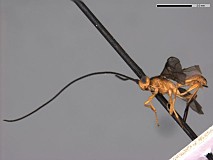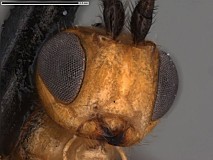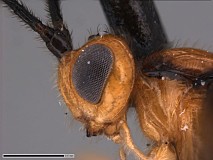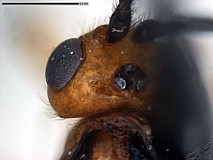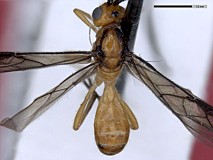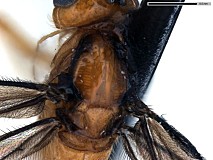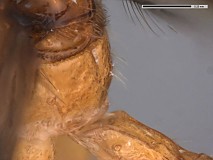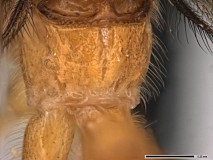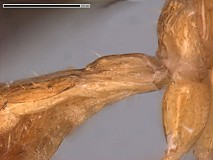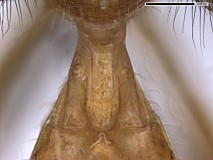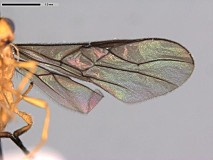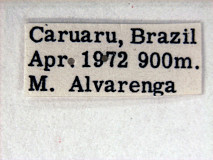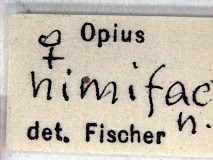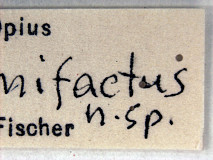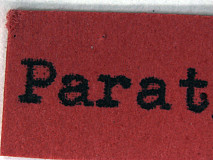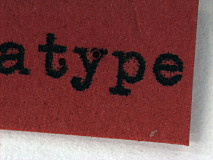Opius nimifactus Fischer
Opius (Pendopius) nimifactus: Yu et al. 2005, 2012 (electronic catalogs).
This species was placed in the subgenus Pendopius by Fischer (1979) because of the absence of sculpture on T2. The shagreened sculpture on the metasoma appears to vary intraspecifically in opiines when there is sufficient material for comparison, and is often extremely weak in some of the species of the ingenticornis species group. We therefore do not consider the sculpture pattern alone to be adequate for characterizing subgenera or species groups, and treat it as variably present or absent in the ingenticornis species group. Both O. macrocornis and O. nimifactus fall within our concept of the ingenticornis species group, resembling species with relatively reduced sculpture and darker, thicker flagellar setae such as O. curiosicornis .
Opius nimifactus is similar in many respects to O. macrocornis . Opius macrocornis is more uniformly pale orange: lacking the black tegula and dark margins of the mesoscutum that characterize O. nimifactus. Both species are characterized by greatly reduced propodeal sculpture, relatively smooth T1, and absence of any shagreening on T2. T1 anteriorly is more gradually sloping in O. macrocornis than in O. nimifactus. There is a patch of sculpture between the notaulus and the anterior-lateral margin of the mesoscutum in O. nimifactus but this area is largely smooth in O. macrocornis. The mesoscutum is also weakly declivitous in O. macrocornis but flatter in O. nimifactus. Fischer (1979) provides additional comparison of the two species.
Additionally, as in all other members of the ingenticornis species group, this species can be further characterized as follows: Mandible short, broadly triangular, dorsal margin strongly angled ventrally, broadly exposing labrum. Clypeus shaped as a broad crescent, nearly hemispherical, flat to weakly protruding ventrally, ventral margin shallowly concave, rarely appearing truncate. Malar sulcus distinct, complete. Antenna unusually long, approximately twice longer than body; first flagellomere slender, longer than second, with long, narrow plate sensilla. Occipital carina broadly absent dorsally, the gap in dorsal view at least as wide as distance between eyes; carina well developed laterally and ventrally, widely separated from hypostomal carina ventrally. Pronope deep, wide, posterior margin at least weakly overlapping base of mesoscutum, thus obliterating posterior transverse sulcus medially; vertical carina absent on pronotum laterally. Mesoscutum without midpit; notaulus short, curved, pit-like anteriorly, narrowing and evanescent posteriorly. Propodeum with median depression at least anteriorly, never with median longitudinal carina. Mesopleuron without sternaulus, precoxal sulcus unsculptured, absent or very faintly indicated; hind margin of mesopleuron not obviously crenulate on dorsal 0.5. Fore wing 2CUb arising from or near middle of first subdiscal cell. Hind wing with RS distinctly infumate; m-cu absent. T1 with dorsal carinae parallel or nearly so, extending from base to apex; laterope large, deep; dorsope absent.
There are no specimens currently determined for this OTU, or those specimens determined for this OTU are not yet mappable.
Paratype labels are shown in Figs 1-5.
This material is based upon work supported by the National Science Foundation under Grant Number DEB 0949027 and associated REU supplement 1213790.
Any opinions, findings, and conclusions or recommendations expressed in this material are those of the author(s) and do not necessarily reflect the views of the National Science Foundation.

